
by Katie Thompson
Norwich certainly isn’t short of some incredible history. As a city with over 1000 years of it, we’ve seen Vikings, Normans, rebellions, booming industries, WWII and more! We’re a city that’s proud of our heritage, one that’s home to an amazing array of churches and pubs. And at the heart of Norwich’s independent spirit, you’ll find the Lanes.
As you explore the City of Stories, you’ll come across the Lanes’ pavements and posts- a collaboration with local artists, the city council and HEART (Norwich’s Heritage Economic and Regeneration Trust). The pavements are special carved slabs, each depicting a picture and a title, while the posts are red with sculpted finials. Every one represents a story from Norwich’s history- some that even locals don’t know!
Take a good look and you’ll discover a hint of our history, our people and our places- these beautiful pockets of information are a nod to far bigger stories. There are 12 different post designs and almost 50 pavement slabs to find! See if you can discover them in a day or uncover a new one each time you visit.
Here are the tales of some of the most interesting. Then it’s up to you to see if you can find them all (check out the maps below)! This is our guide to the Norwich Lanes pavements and posts.
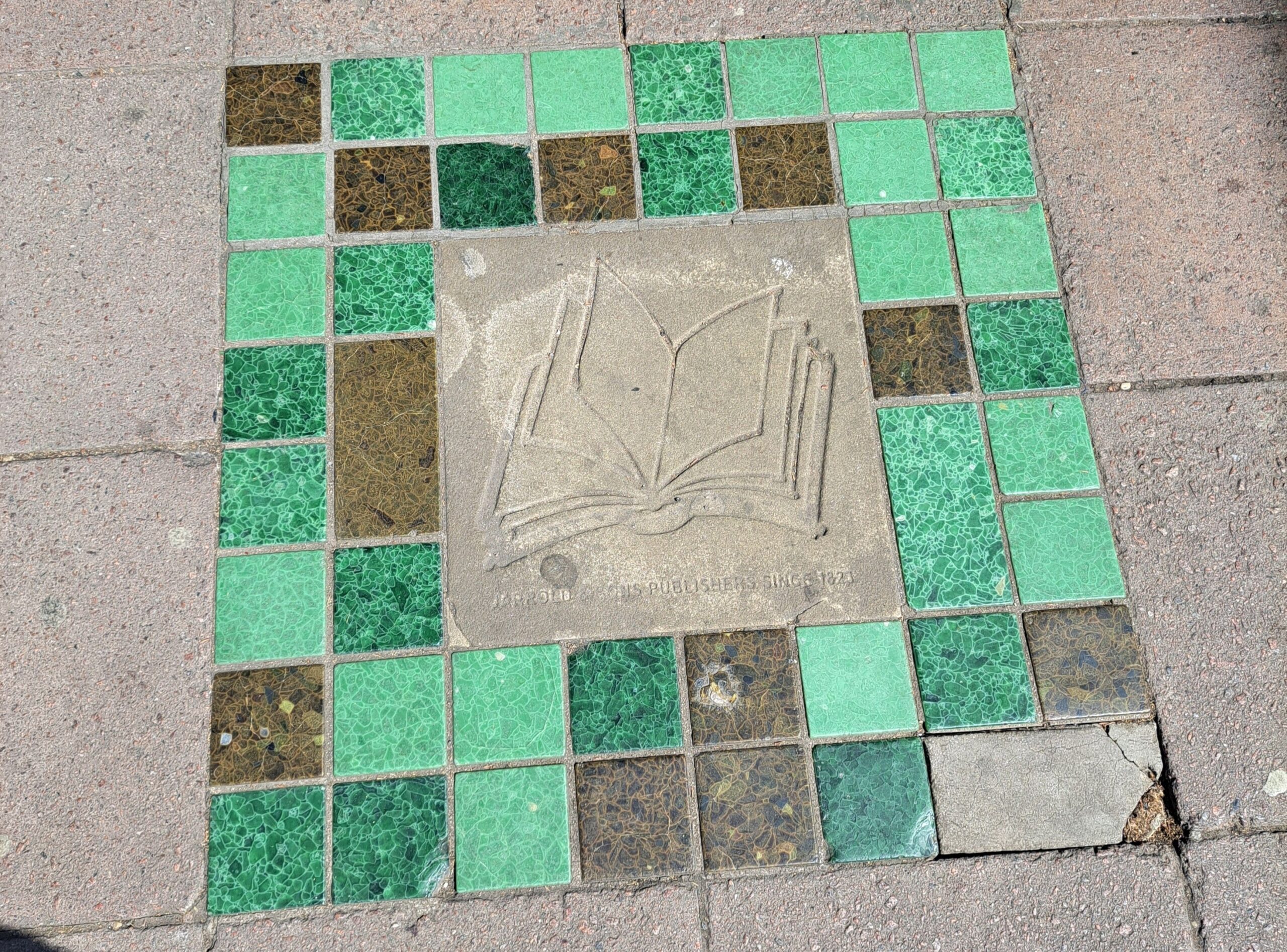
The Lanes paving slabs are a gateway to the city’s stories
The Lanes’ commemorative paving slabs were designed by local artist and Norwich University of the Arts graduate Sally Barrett in 2007. Focussing on the city’s industrial and social past, each one is surrounded by eye-catching alternating black and green stonework.
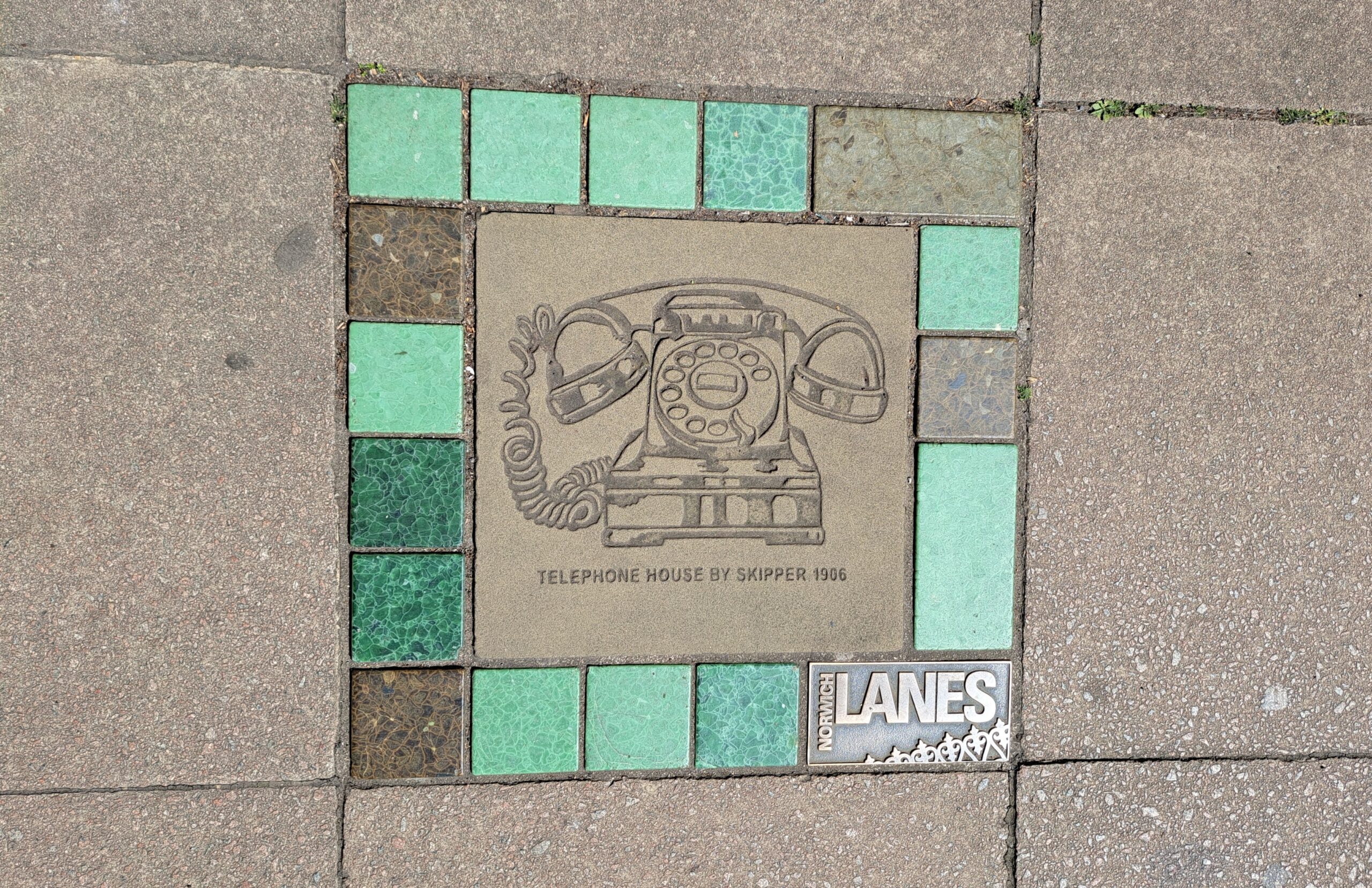
The Telephone House is just on one George Skipper’s beautiful architectural designs in Norwich
Start at the top of the Lanes on Upper St Giles. Look out for Saint Giles with Hind, created in honour of St Giles-on-the-Hill church. It’s said that when Saint Giles lived with a pet hind, he was physically wounded whilst protecting her. Today, he’s the patron saint of disability.
Heading along St Giles Street, a pair of weighing scales shows the Street of Solicitors. It’s here that Fosters of Norwich (still active today) was founded in 1761 among others.
St Giles Street is home to some magnificent architecture, too. Not least the Telephone House by Skipper (who also designed the Royal Arcade, Jarrolds and Marble Hall), crafted from Bath stone with a marble plinth and columns in 1904 – 1906. Spot the rotary telephone outside St Giles Hotel. Next door, Norwich Masonic Hall (depicted by a square and compasses) is home to the Provincial Grand Lodge of Norfolk. Founded in 1723, it’s one of the oldest in England, whose honorary members include Queen Elizabeth II and Winston Chruchill!
While You’re Here: Indulge in a sweet or savoury waffle (or both) at The Waffle House– it’s been a Norwich staple for 47 years! Cut through to neighbouring Bethel Street and explore the beautiful South Asian crafts of The South Asia Collection and their Country and Eastern shop.
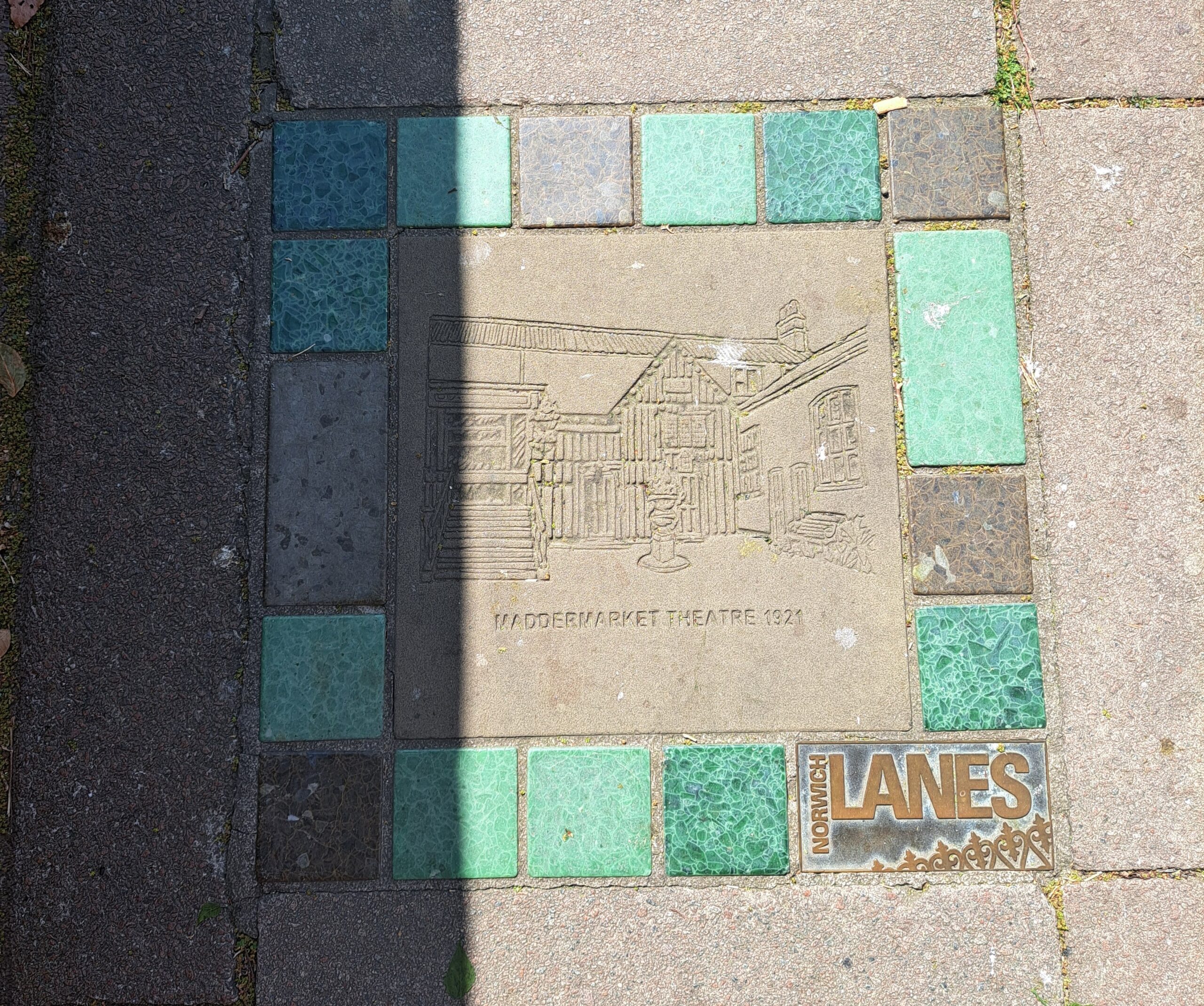
Tucked away along St John’s Alley is the Maddermarket theatre
Heading left down Lower Goat Lane brings you to Pottergate. Outside Strangers Coffee, you’ll see a carving with two skeins of wool: The Strangers Were C15 Weavers. This independent coffee shop and Strangers’ Hall are both named for Flemish and Dutch Walloon refugees who came to Norwich fleeing religious persecution from Spanish Catholicism. You’ll spot their legacy in wide weavers’ windows and ‘plains’ across the city!
Further along Pottergate, you’ll discover the site of the former Norwich Fire Station 1899 – 1934, outside clothing store Mod One with the City of Norwich Fire Brigade badge. Before 1899, the municipal fire engine was kept in the Guildhall!
Make your way along St John’s Alley, past the slab for the Farriers Arms (a mallet and anvil, now the Belgian Monk) and towards the Maddermarket Theatre (this paving is an accurate representation of its frontage). Originally, this was the site of a chapel, but with the opening of The Cathedral of St John the Baptist, it became the permanent home of the Norwich Players from 1921. Playwright George Bernard Shaw even said, “There is nothing in British theatrical history more extraordinary than [the] creation of the Maddermarket Theatre”. Wow!
While You’re Here: If your nose hasn’t already sought it out, pop by Grosvenor Fish Bar for fresh fish and fluffy chips (or mussels, bass or tuna if you want something different)! Then check out what’s on at local community theatre the Maddermarket for an evening of entertainment.
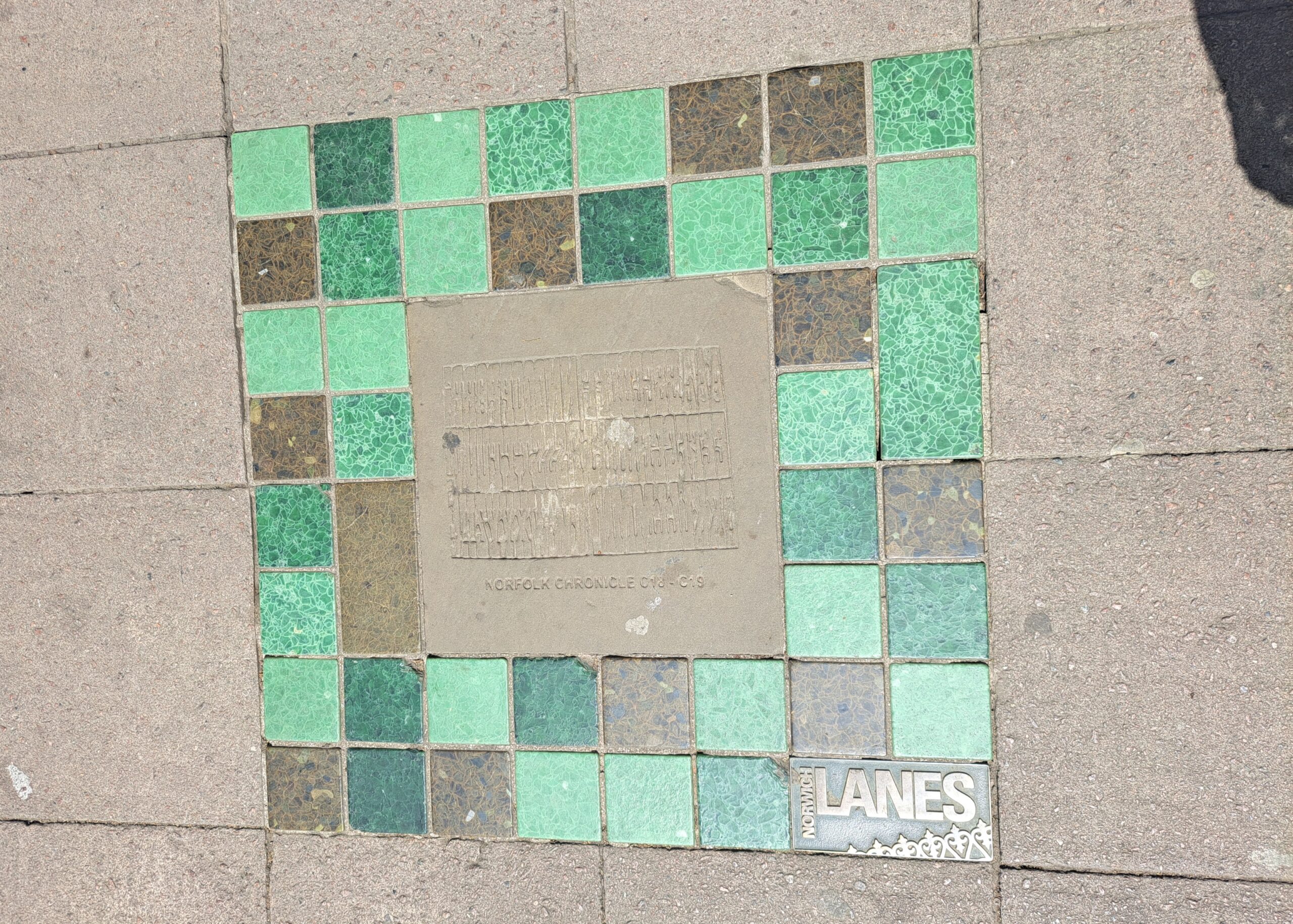
Norwich’s literary heritage includes publishing, authors and newspapers like the Norfolk Chronicle
From here, head up St John’s Maddermarket and along Lobster Lane to Exchange Street. As the former site of The Corn Exchange, you can see where it gets its name from! Outside Jarrolds, the paving shows a sheaf of corn in honour of the building which was demolished to make way for the department store’s expansion in 1964.
Speaking of Jarrolds, at the main entrance is carving with an open book honouring the family’s printing history: Jarrold & Sons Publishers Since 1923. In 1823, John Jarrold II set up a store that was well-known for its printing, stationery and publishing. He established a printing press in Norwich in 1815, set up a printworks on Little London Street in 1860 (before moving to St James Mill in 1902) and even printed the first edition of local author Anna Sewell’s Black Beauty in 1878! Today, pieces from the John Jarrold Heritage Collection form part of the Norwich Printing Museum at Blickling Hall.
Nearby on Guildhall Hill, a paving slab commemorates the Norfolk Chronicle C18 – C19 with an alphabet printing letter block. This newspaper is another foundation that makes Norwich the City of Stories. Unlike its contemporaries, the Norfolk Chronicle covered local, regional and international news, including the industrial revolution and Napoleonic wars.
On the other side of Jarrolds in Little London Street, there’s paving with a pair of stockings: Street of Goldsmiths & Stocking Makers. Stocking production was a key part of the textile industry in the late 16th century as a means of income for poorer families. Meanwhile, Norwich’s place as the country’s second city made it a perfect location for goldsmithing. Some of the city’s many merchant marks are those of local goldsmiths, while today, family businesses like Sonkai (found in the Royal Arcade) continue this legacy.
Norwich was also a pioneer of fashionable Furniture & Cabinet Makers in the 1800s (shown with an image of wooden furniture outside City College Norwich), thanks to makers like Trevor Page & Co, Barnard, Bishop and Barnard, and Thomas Smith.
While You’re Here: You couldn’t visit Exchange Street without popping into Jarrolds! Treat yourself in their incredible contemporary food hall on the lower ground floor or peruse 5 floors of over 50 departments. Close by, explore the beautiful trinkets and gifts of Sostrene Grene.
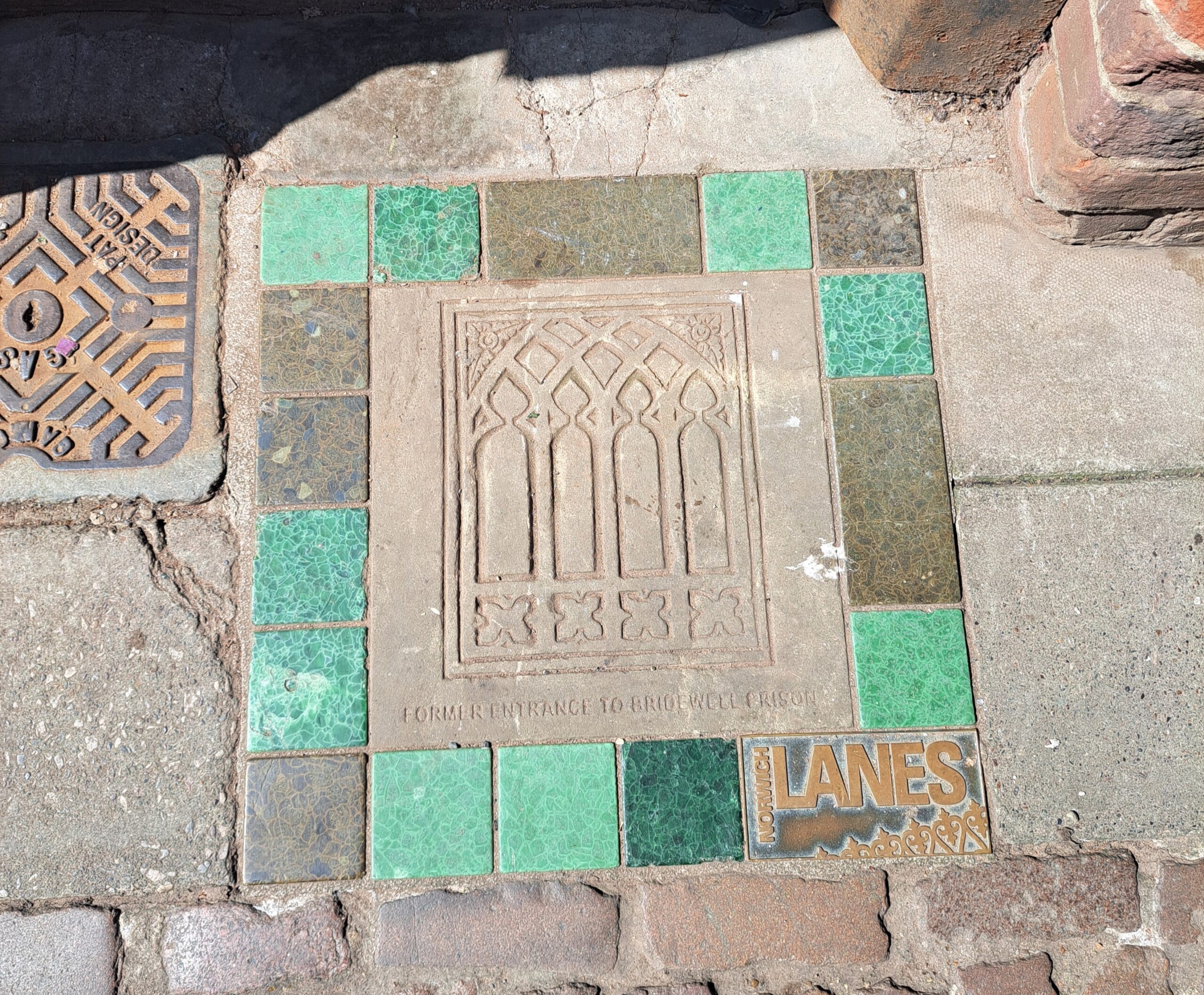
This plaque marks the former entrance to the Bridewell prison- right next to the original door!
Walk along London Street to Swan Lane. Here you’ll find a carving of a pestle and mortar for George Birch– an apothecary, grocer, Sheriff of Norwich (1604) and Mayor of Norwich (1621).
Further along Swan Lane, outside Logan’s, is a swan. What is now Turtle Bay was the White Swan pub from 1700 – 1859. What makes this pub special? Its last licensee was none other than prize fighter and Norfolk native Jem Mace. A blue plaque also marks the name of this English Welterweight, Heavyweight, Midweight and World Heavyweight Champion! And- look up- above jewellers Dipples, an eye-catching sign still depicts the white swan.
Heading further into the heart of the Lanes, make your way to Bridewell Alley, home to the Museum of Norwich. On St Andrews Hill at the back of the museum, is an unassuming wooden door. Have you spotted it? This very door is depicted on the pavement just outside- it’s the former entrance to the Bridewell. For over two hundred years, this building was a prison and house of correction. It was even home to local legend Peter the Wild Boy in Georgian times- see if you can spot the post with him on it, too! Today, you can visit the Museum of Norwich to find out about this historical building- just one of many significant spots in the Norwich Lanes.
While You’re Here: Browse the beautiful displays of Dipples’ jewellery and watches, before tucking into tasty sandwiches at Logan’s or authentic Italian street food from Saporita. Don’t forget to take a look around the Museum of Norwich for even more on the Bridewell!
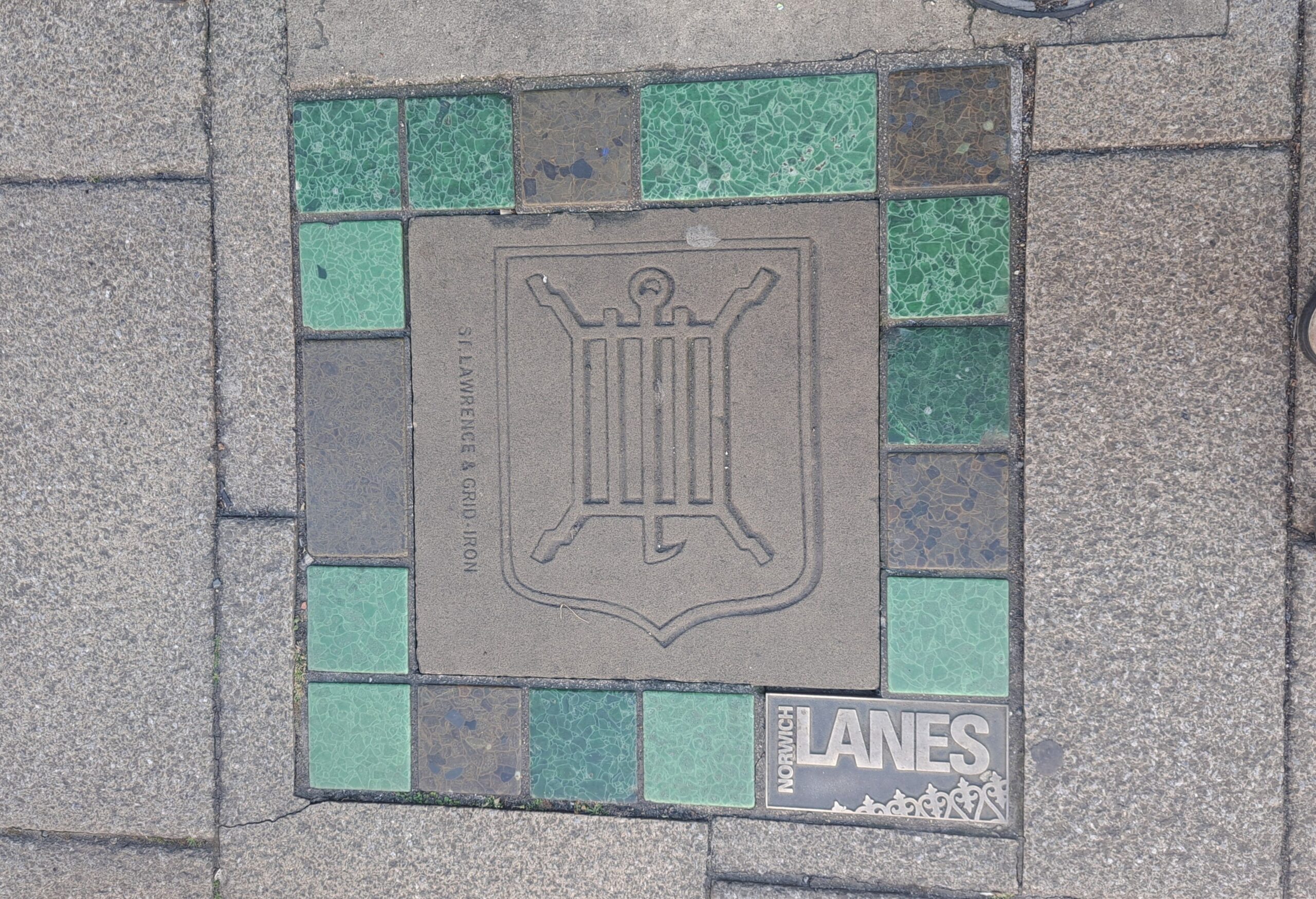
There are many stories behind the Saints of Norwich’s churches
End you journey down St Benedicts Street- one of the best spots in the city for good food and a refreshing pint. You’ll notice most of the paving slabs here are for former public houses, but take note, two of them are still as popular as ever. The Ten Bells– a handheld bell- has been a buzzing pub since 1760 and just a few doors down, the Plough (identified by the ‘plough’ constellation) opened in 1813 in a former 17th century merchant’s house.
St Benedicts Street is also known for its churches. Opposite St Margarets church, you’ll see a carving depicting Saint Margaret and Dragon. And outside St Laurence church is an image of Saint Lawrence and Grid Iron.
While You’re Here: Spend an hour or two with friends and family playing board games and eating tasty plant-based dishes at Slice + Dice or treat yourself to a mouthwatering fine dining experience at Benedicts. End your day with live music or comedy at Norwich Arts Centre.
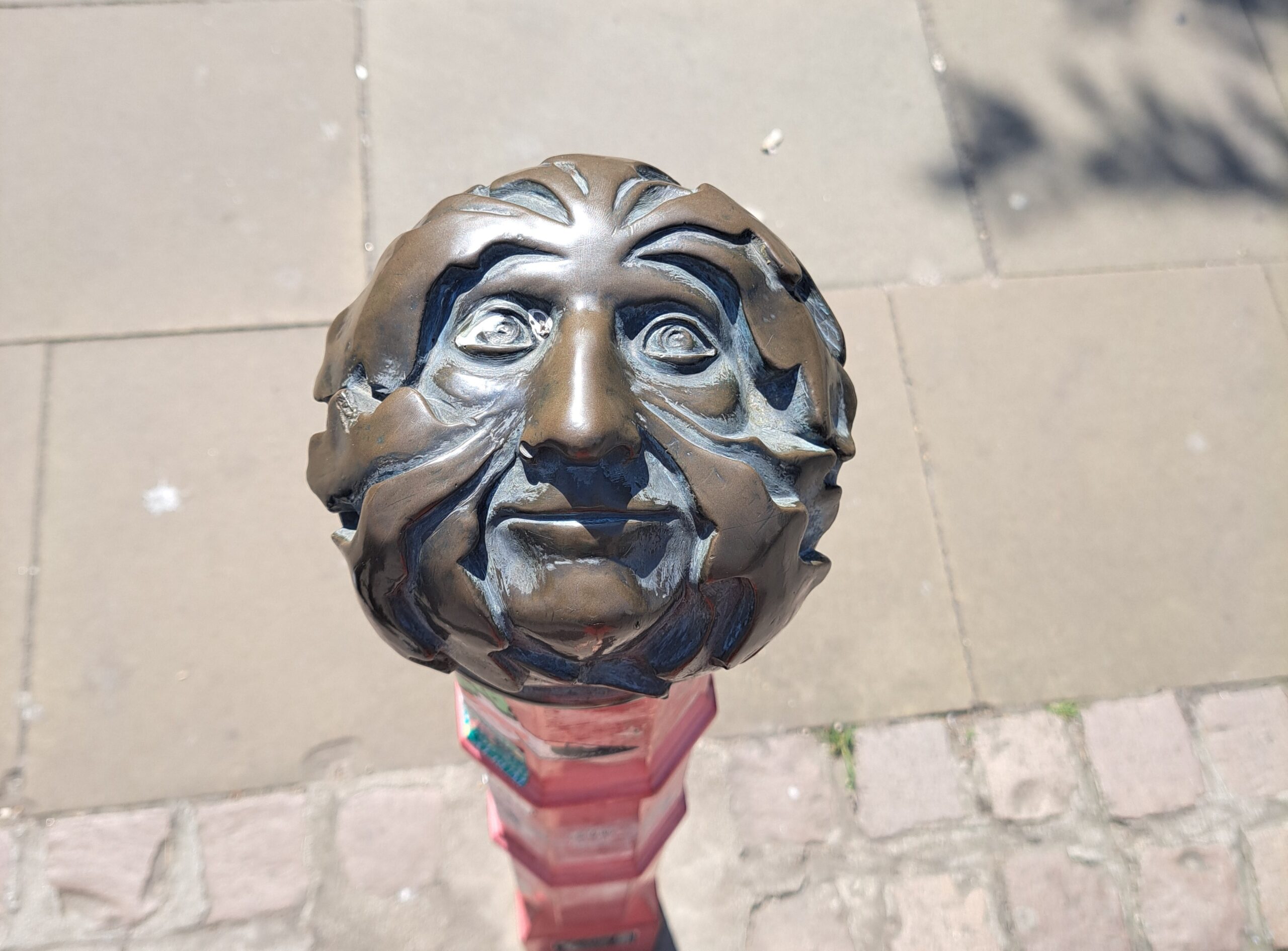
Have you spotted the green man in Norwich’s churches?
When it comes to the Lanes posts, there are 12 original designs (each one created in 2007 by local sculptor Oliver Creed) across 22 locations. You’ll spot their bright red colour- madder red to be exact, in honour of the weaving plant used for dying textiles in the 17th century. And up close, take a look at their specially carved finials, each one designed in honour of its location.
Gargoyle, Upper St Giles- opposite St-Giles-On-The-Hill church, this finial is based on a gargoyle on the Grade I listed medieval building. Fun fact: the tower is 120ft tall, the tallest in Norwich!
Buck, Lower Goat Lane- adjacent to Imelda’s shoe shop, this post is topped with a male goat in honour of the street name.
Saint John and his Sheep, St John’s Alley- on the intersection with Charing Cross Road, this post depicts the saint the street is named for. Saint John became associated with lambs and sheep after baptising Jesus as the ‘Lamb of God’.
Lobster, Lobster Lane; Doves, Dove Street; Swan, Swan Lane- these ones do exactly what it says on the tin! Lobster Lane was named for the Lobster Inn pub, and in turn, the finial for this street shows two lobsters. Similarly, Dove Street depicts two doves and a swan’s head used to adorn a post on Swan Lane (sadly no longer there).
Wild Boy, Bridewell Alley- Peter the Wild Boy (whom the Wildman pub is also named for) was a prisoner in the Bridewell- now the Museum of Norwich, who was brought to England from Germany by King George I. After escaping from the care of supervision in Hertfordshire, he was traced to Norwich after a fire broke out in the Bridewell.
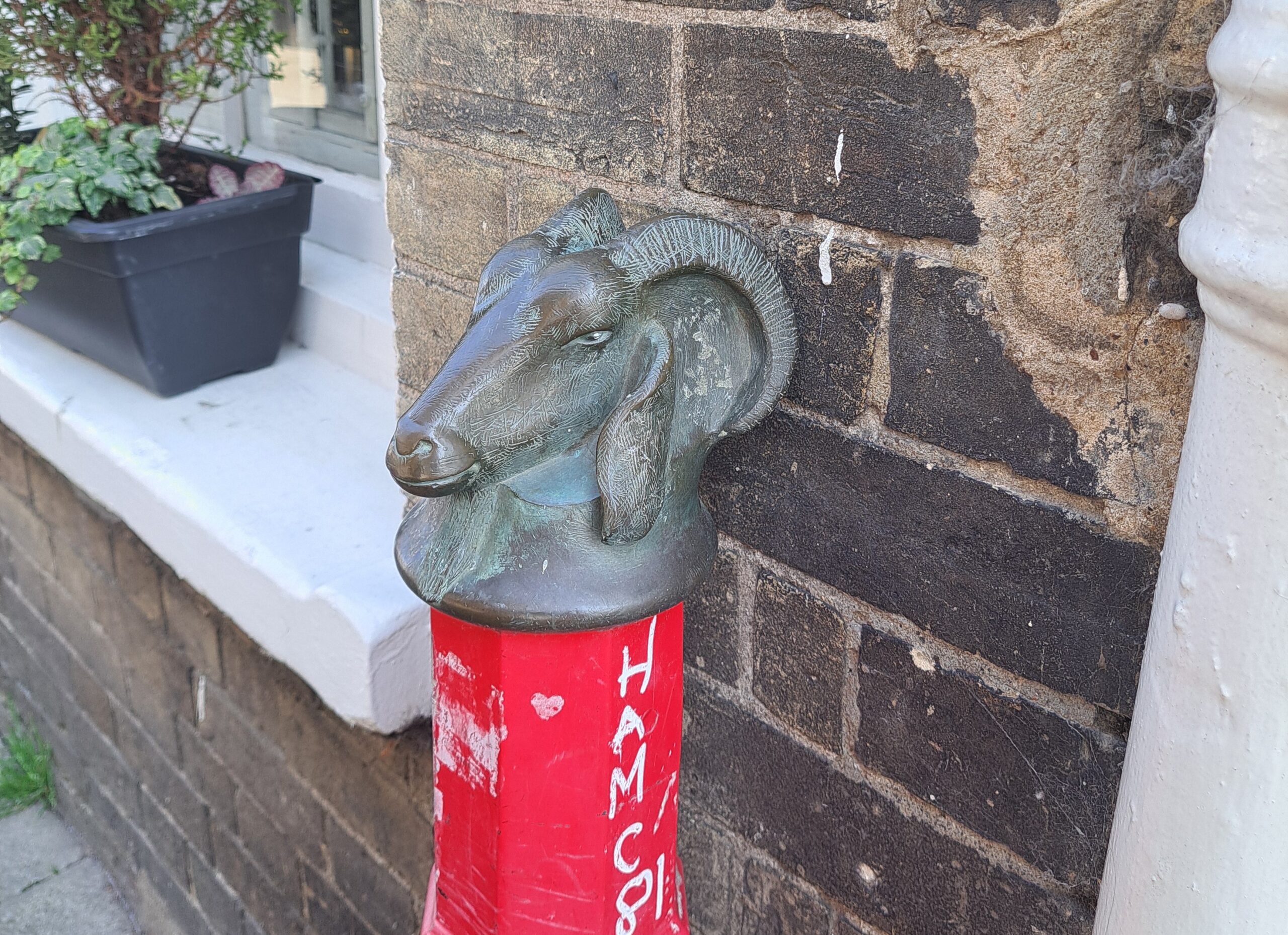
A buck sits proudly at the entrance to Lower Goat Lane
Green Man, Bridewell Alley- at the northern end of Bridewell Alley, one of the Lanes posts depicts a Green Man, possibly from nearby St Andrews church or Norwich Cathedral. This symbol is common in Norfolk churches, although no-one quite knows what he represents. To ward off evil? A link to the Garden of Eden? You decide!
Cherub, St Benedicts- at the western end of St Benedicts is the site of St Benedicts Gate. Its medieval nickname was Heaven Gate thanks to the number of pilgrims passing through on the way to the Walsingham Shrine.
Griffin, St Gregory’s Green- found next to St Gregory’s, this post is based on a griffin which is seen in the adjacent Grade I listed medieval church.
Ram, London Street- although no longer there, a ram once adorned the post on London Street in front of Cosy Club. This used to be the horn working area of the city- where items like books, spoons, combs and more were crafted from horns!

Saint John and his sheep- associated for baptising Jesus as the ‘Lamb of God’
Madder Plant- half of the posts show the madder plant, a perennial plant whose roots produce a vibrant red dye. The plant has been used since ancient times on leather, wool, cotton and silk, as well as during Norwich’s booming textile trade, notably for Norwich shawls. These famous shawls were so popular in the 1800s, that they were shipped globally to royal courts. Even Queen Victoria is said to have bought two at the 1851 Great Exhibition! (See an example for yourself in Norwich Castle!). You can even see the madder plant growing in The Herb Garden at Norwich Cathedral!
By subscribing you will be added to our Newsletter mailing list.
